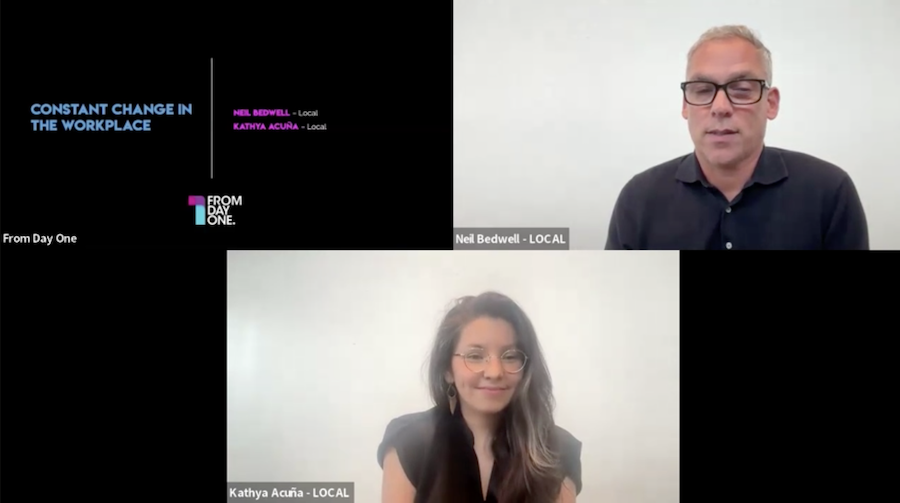Constant Change in the Workplace: Getting It Right While Maintaining Employee Trust


“CEOs in the U.S. are saying that they’ll likely have to reinvent how their company delivers value in the next three years,” said Kathya Acuña, head of strategy for LOCAL. The rapid advent of AI and ongoing reimagination of roles and skill sets prompts the question: “How does constant change impact us as humans?”
The human brain craves stability Acuña shared during a From Day One webinar on navigating change. So, a constant sense of change decreases mental bandwidth, impacts emotions, and can make it hard to sustain focus on moving targets. Poorly sequenced change or unclear communication can cause employee overload, decision fatigue, and distrust. “If this is what’s happening at an individual level,” she said, “then the question becomes: what if we amplify it?” The potential for decision fatigue to scale company-wide gives organizations an opportunity to embrace employee-centered change practices to avoid the disruption of company culture.
“The founding philosophy of LOCAL, and the thing that we preach more than anything else, is that employees are not resources. They’re customers. Really, they are the first customers for everything that you’re doing,” said Neil Bedwell, co-founder and president of LOCAL. “You have to win them over in order to succeed,” he said.
LOCAL has reframed the concept of marketing into a change management tool that they call change marketing, which is used to drive employee engagement and help sustain internal change. With an innovative three-step process—insight, story, craft—the company created a culture of change readiness and accelerated action.
During the insight phase, Acuña says, put your target audience at the center by gathering insights to understand their problem and associated perceptions. Next, she says, look at the story of how people will experience the change. Rather than just letting the change happen to them, offer opportunities for them to co-create with you and have a sense of agency. The final phase, craft, “is really about how do you [take the change] to people the same way you would [take a product] to market?” Create attention-getting experience content that drives engagement and adoption.

To demonstrate the impact of this process, Bedwell shared the story of a client that rolled a new training program out to its large employee population. Employees were already overloaded and the organization’s culture did not value the practice of learning new capabilities. So by repositioning the program from mandated learning to a career development opportunity, and breaking the content into manageable app-based modules with personal pacing and custom pathways, he said that the completed initiative was mentioned in the company’s annual report and “called out by the CEO as a standout initiative for the year, as something the company should do more of.”
Another learning and development client found that only 44% of people managers have actually received any management training and opted to reflect on their company’s investment in leadership training. In partnership with LOCAL, they reviewed employee engagement surveys to understand the performance and support level of their management team.
Through a series of focus groups and interviews with people leaders, Acuña says, the team learned that a lot of these leaders had been promoted due to their success as individual contributors, but not necessarily their leadership skills. Working with LOCAL, the company reviewed the team structure and established clear behaviors to define leadership within the organization and used immersive training techniques to distribute the information to people leaders. After one year, she said, the next employee engagement survey showed a 12% increase in leadership support, exceeding the enterprise-wide benchmark of 3%.
To support companies seeking their own cultures of change readiness, Bedwell and Acuña offered ideas to incorporate change marketing concepts into established processes. In addition to the key elements of the insight, story, and craft phases, listen to employees to understand what they need and identify points of friction to ensure they are addressed. Keep change marketing communications simple and memorable, meeting your audience where they are and with respect.
“Find your promoters.” Bedwell said. “Inside your business, there will be people who are already advocating for what you do. Find them and empower them. They’re a change network for you.” Once people are engaged, says Acuña, guide them through their next steps with clear calls to action.
Acknowledging that consensus decision-making can overcomplicate change messaging, she suggested that cross-functional teams align early on the program’s objective and shared criteria. This helps reduce confusion across employee populations and improves the likelihood of success.
Bedwell agreed, stating “Everyone should get the red pen out on the brief for the work, and then someone who understands the audience should write the communications. A brief allows all of the input to be gathered into a format that someone with objectivity can turn into communication that meets the audience’s need.”
Editor’s note: From Day One thanks our partner, LOCAL, for sponsoring this webinar.
Jessica Swenson is a freelance writer and proofreader based in the Midwest. Learn more about her at jmswensonllc.com.
(Photo by Umnat Seebuaphan/iStock)
The From Day One Newsletter is a monthly roundup of articles, features, and editorials on innovative ways for companies to forge stronger relationships with their employees, customers, and communities.